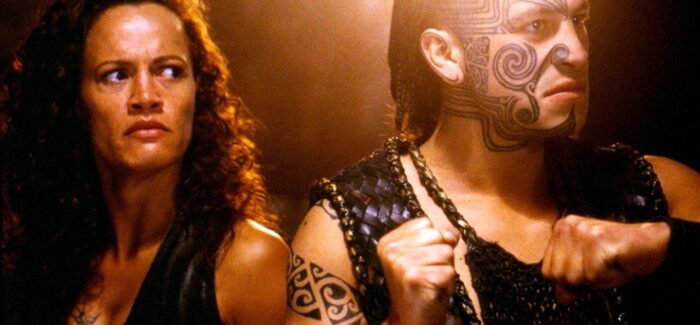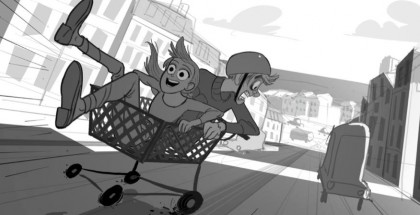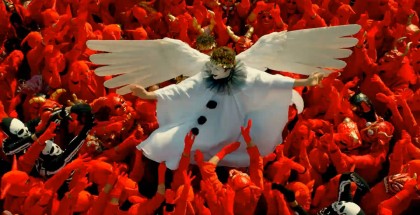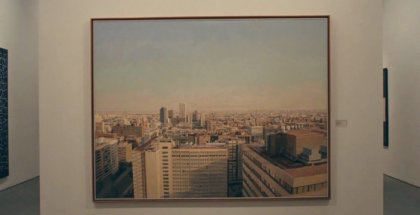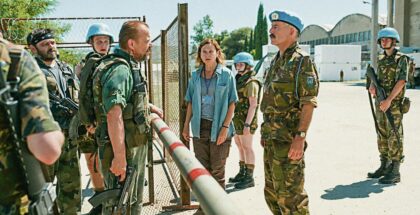Gender and Violence in the Working-class Māori Community as Depicted in Once Were Warriors
Gender and Violence in the Working-class Māori Community as Depicted in Once Were Warriors:
View on Māori Masculinity in the Analogy of Self-reflection and the Colonial Gaze
“You know the rules girl, keep your mouth shut and your legs open” and “Cook the man some eggs” –there is hardly a simpler and to the point ‘representamen’ summarizing gender and violence relations in Once Were Warriors than these two lines. In a way they are able to encompass the standardized aggressive patriarchal order, violence (both verbal and non-verbal) and the power relations determined through the excessive use and exhibition of masculine physicality – and physical violence as its derivate – as portrayed in the Māori family of the main character’s Father figure Jake “the Muss” Heke. This essay will focus on exploring the relation between gender and violence in the film and the delicacy of representation, inspecting the Māori self-interpretation and the one coming from the ‘colonial’ prism.
Once Were Warriors is a powerful and emotional social realist drama focusing on the urban and integrational realities that a working-class family from the Māori community confronts in their struggle to cope with the ‘Pākehā’-modeled (the term for White New Zealanders used by the Māori community) modern life’s rhythm and their inherited cultural values and traditions. The film gives a glimpse to the hierarchal structure of an urbanized Māori working-class family consisting a life story of a ‘housewife’ looking after the kids, and – as intentionally represented – an overly violent and irresponsible father figure, who instead prioritizes drinking at the local bar with his male friends, body flexing and regular violence. As a byproduct, the situation reflects the inability of the children to experience a rather peaceful growth through their youth period. The reference goes along with the narrative of a normalized abuse and domestic violence towards women in the wider context of the working class Māori community represented in the film. In other words, suggesting that violent practices have socio-cultural and economic roots within the community.
It would not be a fair take to judge the occurring events in the film solely from the perspective and morals of the Western civilization. We must consider that, in a way, the supposed ‘villain’ – Jake the Muss – is stubborn in his way of life and this seems to be highlighted intentionally in the film. He does not rely on the institutions for justice, as shown in the final scene of revenge for his daughter, nor that is he worried about the boy being taken off. It simply implies a different belief system, a way of life, a survival instinct that – according to him – needs to be appropriated and taken as a guide for life. Though as proven from the revenge, this mindset does not mean that a certain form of care and love is absent in his relations with the family members.
As mentioned before, the story is predominantly loaded with signs and images of a normalized violent and toxic masculinity on one hand, and a suffering submissive femininity on the other – but in this particular case a resisting one as well. A perfect example is the suggestion made to the central female character, Beth, by one of her female friends: “You know the rules girl, keep your mouth shut and your legs open”. The only noted resistance that we encounter throughout the film to this order of things and established power relations is from her, who unlike other women represented in the film, does not fully and submissively obey to the order of this excessively violent form of patriarchy. She rather exhibits an unavoidable resistance, and in doing so, evokes on herself a very violent response. About her determined and prideful character – not a common trait for a woman in the acts we encounter in the film – we take record on the promise she gave to herself for not returning back to her village and tribe, for the sake of which, she is ready to endure the violence and the abuse. However, it is evident that although the domestic violence is central to the family life routine, some subtle love relations do exist between the partners. When added to this the presence of the children, the whole becomes the main source for the prolonged survival of the relationship and the family as such. This detail leaves space for a common conception that the conceived violence present in the working-class Māori community has cultural roots, and perhaps needs to be examined from a different – historical – perspective of causality and the colonization’s effect on the indigenous forms of social existence. The movie does indicate to this dialectic fact through the name, and it clearly creates a connection between the ‘Warrior’ attributes of the ancient man figure of the Māori civilization and the deteriorating effects of colonization, modernity and urbanization, which by gentrifying the indigenous culture could not effectively channelize the physical attributes meant for survival into the newly imposed way of living. This also indicates a change in the position of the woman, who in any case still remains a solid base for the family structure. A structure constantly stricken, and ever since struggling to adapt to the foreign culture and philosophy of social existence.
The culminating part of the movie is undoubtedly the above-mentioned abuse and death of the daughter Grace, which – in an indirect form – suggests the failure or inability of this type of violent patriarchal – power-derived – order to provide protection to close family members, especially from the inner circles of close male friends. The overly centralized masculine power in the family, as well as in the communal life, culminates in the tragic suicide event of the abused daughter, whose importance and value is replaced for that of the father’s male friend. This event also marks the limits of endurance of Beth, and her devoutness to the given promise, which in the end serves as an emotional return to a maternal environment of her past. The cultural identification and the strong – and at points stubborn – character of the woman role personified in Beth, is resolved at the end after the loss of her daughter, an act which points again to the gender relationships in the family – the reliance to the same gender, the loss, and the return to it as a consequence.
The violent motifs represented throughout the film unfortunately are not isolated events, rather confirm that domestic violence in Māori community seems to be an evident widespread phenomena, for which – as suggested from the report – the film had an effect in the increase of official denouncement of such acts, both to the independent organizations and the official institutions (Thompson 2003). The violence has a normalized presence in the love relationship and as such, it could again be understood as a standard and a commonality for the culture in general. Consequently, the suggested increase in denouncing the domestic violence to authorities as result of the widespread awareness through the film, as well as the subsequent productions, had its social effect, bringing us to the political character of the film. This includes the generalized depiction of the urbanized Māori community as one struggling to integrate and survive in the not so common way of living, as well as the questioning of the effects of colonization and how a different living philosophy is projected.
To get back to a rather subtle detail of the passionate and violent love relationship represented in the film, we must not ignore the subtle romance of the couple, which should also be accompanied by the fact that it exists in a cohabitation with the ongoing gender power relations in the family. This representation could not have survived as an isolated case, nor could the film have had the same social effect it did when published. Resisting the accepted forms of violence – which at cases culminate in sexual abuse – inside the relationship and community eventually triggers a violent response, originating from the perceived threat to masculine identity (Kalra and Bhugra).
Another interesting fact to note is the portrayed detail, through the symbolism of the tattoos and traditional performances, which across the urban Māori community signifies survival of the pride element for their background, strongly evident in the youngster’s gangs. However, the film makes a different suggestion for the future choices in addition, when in the end, the boy by refusing the tattoos claims the importance of being a Māori warrior in a subjective sense, with an experiential tattoo inside ones being.
The turning point that brings hope for the direction of the social experience of the community, is portrayed through the generational shift in perception, which gives the film a positive ending, focusing on the displayed change that is taking place in the eyes of the newer generations, one that embraces a different type of Warrior representation, acceptance of the new reality, and a new understanding of the social struggle, peace and communal existence.
All the violence brought to attention in the film is not just an open critique to the Māori violent patriarchy and way of living, but also to the New Zealand’s social regulation as a whole. The marginalized life of the ‘ghetto’ and the treatment it gets from the representatives of the state is highlighted through the film, coinciding with the film director’s Lee Tamahori decision for the treeless ghetto portrayal. The intentional division in the entering scenery, between landscape on the touristic billboard ad and the highway suburb area where the community is located, aims to indicate a strict distinction with the touristic New Zealand that the public is used to see and the bitter reality of the life in the working-class community (Thompson, 237).
The “well-received” phenomenon is an essential segment to be examined in a sociological and political context. It appears that the violence is an extreme example, with exaggerated extremity for dramatic purposes; nevertheless, it does portray a violent image of the working-class Māori man, and the violence that working-class Māori woman undergoes (Thomson 2003: 233). The film was a success in the whole country of New Zealand, and as it is based on a local novel, it received additional institutional support for filmic production. These details do not seem to be accidental. According to Thompson (233) there existed an official state policy for supporting Māori filmic production. The largely White governed New Zealand seems to have had a public interest in creating such a portrayal and this must be examined from an objective perspective (Thompson 233). The political effects of such representation have to be taken into account, and it could not be seen only through the lens of the filmic production and its commercial success, but rather through the lens of cultural identification. Its socio-political effect, as suggested from the report (Thompson 233), had an immediate effect in real life reporting domestic violence. As a consequence, it is important to emphasize the ways that the state policies are intricately affecting the urban Māori culture. Leonie Pihama, a New Zealand Kaupapa Māori academic, in her critique article “Reclaiming Māori Image”, accentuates on the fragile relationship between this group and the state police a common space in the everyday life of New Zealand society. She rightfully throws doubt on the stereotyped representation of Māori men through the colonial gaze. Although Pihana appears to respect the acting and the social effect of Once Were Warriors, as well as the cast involved, she would prefer an alternative take on the Māori reality, insisting on the concept of “who we could be” instead, projecting thus the Māori dream for a resolution to the inopportune historical situation the community is tackling (Pihama).
The film also considers the narrative of distrust between the Māori community and the ‘settler-run’ state and administration. Examples of the occasionally expressed stagnated relation between the group and the state representatives are 1) the incident when the younger son is being taken by the educational institutions and the approach on the situation from both sides and 2) in the cases of police involvement or non-involvement in different occurring situations. Instead, we notice a parallel justice and order hierarchy within the community, mainly maintained through already established power relations, or in other words, physical power relations, as we can see throughout the film. This order is enforced with a concrete presence of physical Masculine dignity focusing on intra-masculine order of respect and play, rather than a focus on the family’s well-being and healthy relations.
In line with the movie suggestions of change in the conception for the preservation of the Māori pride in younger generations, instead of the tradition of plain violence, and rather embracing a non-violent approach to life, Brendan Hokowhitu(2004) also took note on this shift in the expression of Māori masculine physicality and his transformation into the Māori sportsman representative. Although he points for discriminatory encounters during his experience, the reference is on the important detail of the Warrior’s reinvention. With regard to the film, Hokowhitu also points out to stereotypization:
“Unfortunately, as its title suggests, the film intimates that the inherent violence of was, in precolonial times, appropriate for a noble warrior today has become a natural symptom of urban Māori dysfunction. Film’s illustration of the innate Māori male violence is never more than in the repetitive heralding of Jake’s explosive violence by wailing of a purerehua (bullroarer) – the wailing implying the inherent savage (Hokowhitu 263-264).
The Warrior finding himself in an urban surrounding, where the circumstances for survival are different and not necessarily relying on the physical attributes of the male character, incites the need for finding new meanings and functions to utilize. What the physically powerful warrior type of masculinity encounters in the relatively ‘secure’ environment, where his physical power no longer works, nor it is needed for survival is the conception of absurdity. He faces the opposite while the excessive physicality creates unnecessary violence, especially domestically and inside the community. As suggested, one form of making use of it happened through the generic involvement of the Māori men in sports. This parallel of channeling the warrior through the sportsman is a very critical detail in the history of Māori-Pākehā relations, as well as the Māori resolution to the obvious problem of violence. Whereas their survival instinct and the new way of living – where not much physical effort is needed to survive – did not play well, the new channeling of these energies seems to offer a sort of respite and short solution, keeping, nevertheless, other few important questions unanswered, such as the character of games played, their origin, adaptation, etc.
Although the over represented violence and physical masculinity is dominant, a denouncement from a Western-centric perspective won’t work – and perhaps should not work. The enforced imposture of a new foreign culture on the Māori people had seemingly a critical effect on the later development of the cultural life of their community and as exemplified throughout the film, a long-term one. As such, it directly affected the family structures, the gender relations and intra-community power relations. An alternative viewpoint is the consideration of the cultural gentrification that the Māori community was forced to undergo, taking note of the changes in the means necessary for survival, which consist of the sudden disappearance of the need for physical attributes tied closely to their lifestyle, survival instinct and utility purposes. As noticed, sports and other possible solutions for this cultural preservation of masculine physicality might as well be a peaceful scapegoat in conserving the supposed and inherited attribute.
While the gender violence remains an unjustifiable violence, and no possible relativisation will ever suffice to whitewash it, judging it from a different cultural angle always bears the risk for stereotypical misjudgment, and thus a very delicate one. In the film we encounter a two different patriarchal men-privileges: those of the Pākehā world and those of the Māori community, whose privileges differ in form and practice, while being affected by the imposed post-colonial reality that they were subjugated to live in (MAI Review).
We witness a Warrior turned into an abuser in an alien urbanized modernity and the question arises if there was a violence present in the pre-colonial Māori societies as well. The vilification of the physical masculinity needs to be escorted with a thorough analysis of the women role in this whole process and how it affects the concept as such. Consequently, the question arises if there was ever a peaceful functioning in the pre-Colonial Māori community, and does the analysis needs to be sharper in addressing the gender violence if evidence is present there. Nevertheless, it is preferable that this matter is addressed by inside-Māori observers.
Writing from today’s perspective things have changed a lot, but it is likely that the problem keeps resurfacing in different forms, and with each new emergence it will require a new in depth and thorough analysis from within the culture, but always in relation to the surrounding trends of evermore interdependent world. Many questions will remain unanswered and will keep the dialectic alive and dramatic from time to time, but the way how society relates to the relation of gender and violence will keep changing and evolving, and the effect undoubtedly will be felt on the Māori community as well.
Works Cited
Thompson, Kirsten, Moana. “Once Were Warriors: New Zealand’s First Indigenous Blockbuster”. In Movie Blockbusters, ed Julian Stringer. 2003,pp. 230–241.
Kalra, Gurvinder and Bhugra, Dinesh. “Sexual violence Against Women: Understanding Cross-Cultural Intersections”. Indian J Psychiatry. 2013, 55(3): pp. 244–249.
www.ncbi.nlm.nih.gov/pmc/articles/PMC3777345/
Hoeata Chloe, Nikora Linda Waimarie, Li Wendy, Robertson Neville. “Māori Women and Intimate Partner Violence: Some Sociocultural Influences”. MAI Review. January 2011.
www.review.mai.ac.nz/index.php/MR/article/viewFile/443/683
Hokowhitu, Brendan. “Tackling Māori Masculinity: A Colonial Genealogy of Savagery and Sport”. The Contemporary Pacific, Fall 2004, Vol. 16, No. 2 (fall 2004), pp. 259–284
Pihama, Leonie. “Reclaiming Māori Image”. Tewhareporahou.wordpress. February 8, 2014.
www.tewhareporahou.wordpress.com/2014/02/08/reclaiming-Māori-image/
Pihama, Leonie. “A Short Commentary on Boy”. New Zealand Journal of Media Studies. 13(1) 2012, pp. 59–61.
*Marrja e përmbajtjeve të plota apo pjesore të artikujve lejohet vetëm me shtimin e referencës për postimin origjinal në blog.


